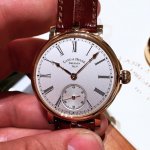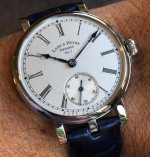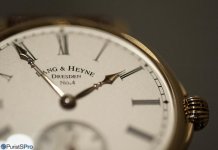Hello,
I'm trying to replicate the surface finish/color of this silver dial. Because of it's tarnish resistant properties, I believe the dial is made from .999 fine silver but I could be wrong. The manufacturer states that the dial is solid silver. Since there are no sanding marks/grain, I cannot determine if this was sanded, electroplated or perhaps bead blasted. I'd greatly appreciate any help that you'd be able to provide.
Also, if anyone has a company that may be able to assist, I appreciate recommendations.
Thanks.
I'm trying to replicate the surface finish/color of this silver dial. Because of it's tarnish resistant properties, I believe the dial is made from .999 fine silver but I could be wrong. The manufacturer states that the dial is solid silver. Since there are no sanding marks/grain, I cannot determine if this was sanded, electroplated or perhaps bead blasted. I'd greatly appreciate any help that you'd be able to provide.
Also, if anyone has a company that may be able to assist, I appreciate recommendations.
Thanks.










